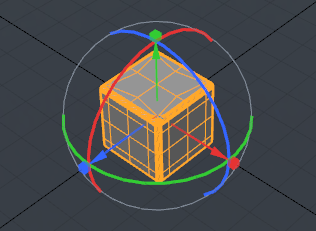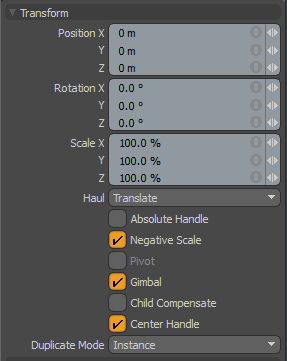Transform

The Transform tool combines move, rotate and scale transformations into a single tool. By using the various handles you can quickly position, rotate and scale in one convenient tool. Hold Ctrl to constrain the position transform to a single axis when hauling, and the rotation transform to 15° increments. After applying a transform amount, middle-click to re-apply the previous offset amount. This way, you can easily apply an edit multiple times. Activate the command in the Model viewport's Basic sub-tab, or by pressing Y.
In the component modes (vertices, edges, and polygons), the tool affects the selected geometry directly. When nothing is selected, it affects all active foreground geometry. Active foreground items are those that are visible and selected in the Items list. In Items mode, the tool affects all the currently selected items in the Items list. If nothing is selected, then the tools appear to do nothing. In material mode, it works the same way as in any of the component modes. Lastly, in the Center and Pivot modes, it modifies the center or pivots respectively.
Note: You need to select either the center or the pivot itself, depending on the mode, prior to activating the tool, as in Items mode, with no selection, the tool appears to do nothing.
When you define any of the falloffs, application of the tool can be attenuated across a user-defined area. For more information on using falloffs, see Using Falloffs.
Once you activate the tool, Modo draws the relevant tool handles in the viewport: arrows for moving, boxes for scaling and circles for rotating. At this point, you can click and haul anywhere in the desired viewport to interactively transform the geometry. Additionally, you may prefer to utilize the various tool handles, constraining the application of the function to one or two axes. The various tool handles are color-coded to match the coloring of the different axes: red for X, green for Y and blue for Z. Hover the mouse over a specific handle until it changes to a yellow color and then click and drag to modify. To interactively scale the size of the handles themselves, use the - (minus) key to decrease size and = (equals) to increase their size.
The Transform tool also respects the settings for action center, and originates the appropriate action from the defined position. For more information on understanding and using actions centers, see Specifying Action Centers and Falloffs .

|
Option |
Description |
|---|---|
|
Transform |
|
|
Position |
Use the X, Y and Z input fields to apply specific offset distance values, calculated from the position the object was in when the tool was activated. When adjusting an object interactively in the viewport, the Position input fields display the current offset distance applied, providing useful feedback. |
|
Rotation |
Use the X, Y and Z input fields to apply specific rotation values. When adjusting an object interactively in the viewport, these input fields display the current offset distance applied, providing useful feedback. |
|
Scale |
Use the X, Y and Z input fields to apply specific scaling values. When adjusting an object interactively in the viewport, these input fields display the current scale factor applied, providing useful user feedback. |
|
Haul |
You have three options available when hauling in the viewport, that is, dragging the mouse when not using the tool handles. Translate allows you to move the selection, Rotate allows you to rotate, and Scale scales the selection. |
|
Absolute Handle |
Applies an additional function to the tool handles allowing you to scale the handle itself without affecting the transform amount. In some cases, this provides finer control over very large or very small adjustments. |
|
Negative Scale |
Enables/disables Modo's ability to interactively apply negative scale values when manipulating the tool handles in the viewport. When disabled, you can always input negative values in any of the input fields directly. |
|
Pivot |
Allows you to easily modify an item's pivot position without the need to go into Pivots mode. |
|
Gimbal |
When enabled, you can assign rotation values numerically, but may arrive at a situation that produces gimbal lock, the loss of one rotation axis when another's value is too close. You can avoid this by disabling this setting, but then you cannot apply specific values within the input fields. |
|
Child Compensate |
|
|
Center Handle |
|
|
Duplicate Mode |
Instance Duplicate |
